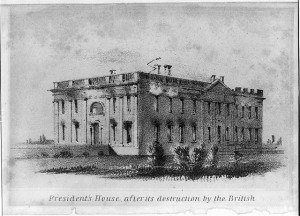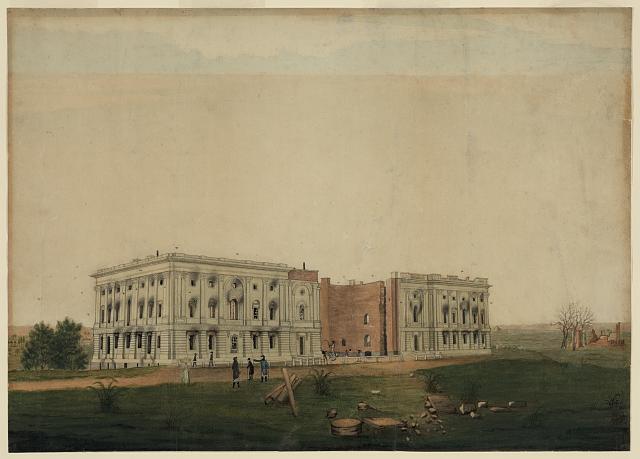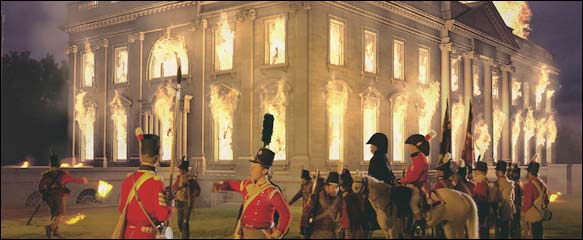
This is a picture of the White House after it was burned by the British in the War of 1812. On June 12, 1812, the United States of America declared war on Great Britain.
There had been a long period of simmering disputes between the nations, including Northwest Territory land disputes, the British impressment of American sailors, and British blockades of American commerce with France during the Napoleanic wars. It was the War of 1812.
In August of 1814, the British landed to the south of Washington, D.C., and marched inland. The only resistance the British Army encountered as they marched towards Washington was the brief Battle of Bladensburg in Maryland, a last ditch attempt to defend the city. B
Because the organized American Army was well to the north near Canada, only a hastily organized militia was available to defend the capital. For the British, this allowed a quick victory after which they were free to enter the city.
The “King’s Own” was one of the units who marched into Washington. In retaliation for the torching of the Canadian capitol of York (now called Toronto), and to disgrace President Madison, they set fire to the president’s residence on August 24, 1814, burning down the White House.
THE BURNING OF THE WHITE HOUSE
1812-1814
The War Of 1812 was between the U.S. and Great Britain.
Official British Account
of the
Capture of Washington D.C.
As reported in The Columbian Centinel December 7, 1814
TO: Great Britain, London, Downing Street, Sept. 27
I have the honor to communicate to your Lordship, that on the night of the 24th inst. After defeating the army of the United States that day, the troops under my command entered and took possession of the city of Washington.
It was determined between Sir A. Cochrane and myself, to disembark the army at the village of Nenedict, on the right bank of the Patuxeut, with the intention of Co-operating with Rear-admiral Cockburn, in an attack upon a flotilla of the enemy?s gun boats, under of the command of Com. Barney. On the 20th instant, the army command its march, having landing the previous day without opposition: on the 21st it reached Nottingham, and on the 22nd moved on to Upper Marlborough, a few miles distant from Pig Point on the Patuxent, where Admiral Cockburn fell in with and defeated the flotilla taking and destroying the whole.
Having advanced to within 16 miles of Washington, and ascertaining the force of the enemy to be such as might authorize an attempt at carrying his capital, I determined to make it, and accordingly put the 1200 men appeared to oppose us but retired after firing a few shots.
On the 24th the troops resumed their march, and reached Bladensburg, a village situated on the left bank of the eastern branch of the Potowmac, about five miles from Washington.
On the opposite side of that river the enemy was strongly posted on very commanding heights formed in two lines, his advance occupying a fortified house, which, with artillery, covered the bridge over the eastern branch, across which the British troops had pass.
A broad and straight road, leading from the bridge to Washington ran through the position, which was carefully defended by artillery and riflemen. The disposition for the attack being made, it was commenced with so much impetuosity by the list brigade, consisting at the 85th light infantry and the army, under the command of Col. Thornton, that the fortifired house was shortly carried, the enemy retiring to the higher grounds.
In support of the light brigade I ordered up a brigade under the command of Col. Brooke, who with the 44th regiment, attacked the enemy?s left, the 4th regiment pressing its right with such effect as to cause him to abandon his guns. His first line giving way, was driven on the second, which, yielding to the irresistible attack of the bayonet, and the well directed discharge of rockets, got into confusion and fled.
The rapid flight of the enemy, and his knowledge of the country, precluded the possibility of many prisoners being taken, more particularly as the troops had, during the day, undergone considerable fatigue.
The enemy’s army amounting to 8 or 9000 men, with 3 or 400 cavalry, was under the command of Gen. Winder, being formed of troops drawn from Baltimore and Pennsylvania. His artillery, ten pieces of which fell into are hands, was commanded by Com. Barney, who was wounded and taken prisoner. The artillery I directed to be destroyed.
Having halted the army for a short time, I determined to march upon Washington, and reached that city at 8 o’clock that night. Judging it of consequences to complete the destruction of the public buildings with the least possible delay, so that the army might retire without loss of time, the following buildings were set fire and consumed- the capitol, including the Senate house and House of representation, the Arsenal, the Dock-Yard, Treasury, War office, President’s Palace (White House), Rope-Walk, and the great bridge across the Potewmac: In the dock-yard a frigate nearly ready to be launched, and a slope of war, were consumed.
The two bridges leading to Washington over the eastern branch, had the enemy been destroyed by the enemy who apprehended an attack from that quarter.
The object of the expedition being accomplished, I determined, before any greater enemy force could be assembled, to withdraw the troops, and accordingly commenced retiring on the night of the 25th . On the evening if the 29th we reached Benedict, and re-embarked the following day. In the performance of the operation I have detailed, it is with the utmost satisfaction I observe to your Lordship that cheerfulness in undergoing fatigue, and anxiety for the accomplishment of the object, were conspicuous in all ranks
An attack upon an enemy so strongly posted could not be effected without loss. I have to lament that the wounds received by Col. Thornton, and the others officers and soldiers left at Bladensburg, were such as prevented their removal As many of the wounded as could be brought off were removed, the others being left with medical care and attendants.
The arrangements made by Staff Sueg?n Baxter for their accommodation have been as satisfactory as circumstances would admit of. The Agent for British prisoners of war very fortunately residing at Bladensburg, I have recommended the wounded officers and men to his particular attention, and trust to his being able to effect their exchange when sufficiently recovered. — Signed: Robert Ross, Major General
Picture of burned United States Capitol building

This is a picture of the United States Capitol building after it was burned by the British in the War of 1812.
The Burning of Washington was a battle that took place on August 24, 1814, during the War of 1812 between the British Empire and the United States of America.
The British Army occupied Washington, D.C. and set fire to many public buildings following the American defeat at the Battle of Bladensburg.
The facilities of the U.S. government, including the White House and U.S. Capitol, were largely destroyed, though strict discipline and the British commander’s orders to burn only public buildings are credited with preserving the city’s private buildings. This has been the only time since the Revolutionary War that a foreign power has captured and occupied the United States capital.
https://www.youtube.com/watch?v=dLP5g-xiBm8



